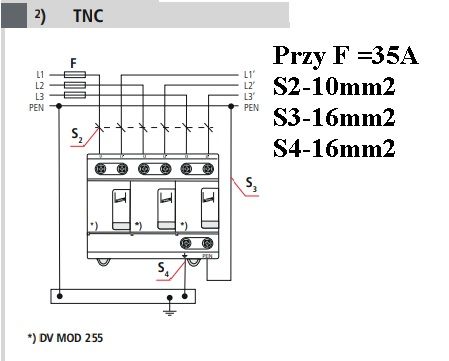Hello
I would like to kindly request your opinion on the switchgear diagram in a single-family house.
Necessary data
- Protection in ZK3a - 32A
- The pre-meter protection is 16A - 3f
- The network system is TN-C (4x70mm? Al cable connection - 115m to ZK3a)
- Power supply to the above-mentioned connection from a straight-through pole.
- A set of valve lightning arresters GZa0.66 / 1.5kVA with grounding type TA3x7 (steel tape 30x5 - 30m) is mounted on the pole
- Distance of the connection point from the transformer 100m
- 250kVA transformer power
- Short circuit voltage 4.5%
- Steel wire 6mm? laid parallel to the cable (after 30 years maybe 3-4mm? remained: /)
I am planning to modernize the internal installation.
I have a project but it is very general and does not provide detailed information about the surge arrester, PEN distribution point, etc.
My questions ?
1. According to the diagram in the appendix, can I split the PEN after the meter (as shown in the picture) or should I do it before the meter?
2. Can I use an AC circuit breaker or do I have to buy an A?
3. Should a surge arrester back-up be used?
4. What about the equalizing connection of the gas pipe when there is no insulation insert?
5. Are there errors in the schematic? If so, what should I improve?
I will be grateful for any suggestions.
I would like to kindly request your opinion on the switchgear diagram in a single-family house.
Necessary data
- Protection in ZK3a - 32A
- The pre-meter protection is 16A - 3f
- The network system is TN-C (4x70mm? Al cable connection - 115m to ZK3a)
- Power supply to the above-mentioned connection from a straight-through pole.
- A set of valve lightning arresters GZa0.66 / 1.5kVA with grounding type TA3x7 (steel tape 30x5 - 30m) is mounted on the pole
- Distance of the connection point from the transformer 100m
- 250kVA transformer power
- Short circuit voltage 4.5%
- Steel wire 6mm? laid parallel to the cable (after 30 years maybe 3-4mm? remained: /)
I am planning to modernize the internal installation.
I have a project but it is very general and does not provide detailed information about the surge arrester, PEN distribution point, etc.
My questions ?
1. According to the diagram in the appendix, can I split the PEN after the meter (as shown in the picture) or should I do it before the meter?
2. Can I use an AC circuit breaker or do I have to buy an A?
3. Should a surge arrester back-up be used?
4. What about the equalizing connection of the gas pipe when there is no insulation insert?
5. Are there errors in the schematic? If so, what should I improve?
I will be grateful for any suggestions.





